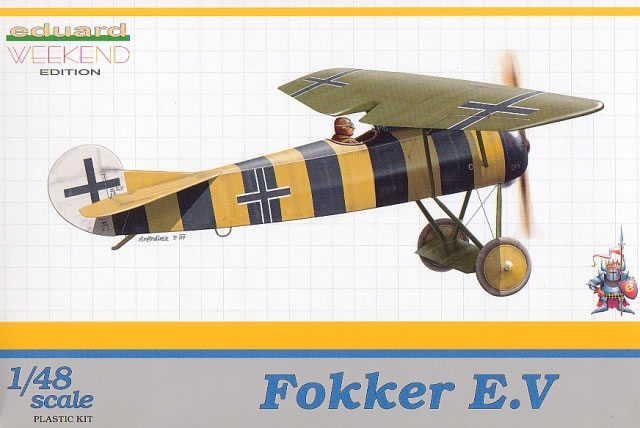|
Pfalz D.IIIA ProfiPACK
Dual Combo

Eduard, 1/48 scale
S
u m m a r y |
| Catalogue Number: |
Eduard Kit No. 8480 - Fokker E.V “Weekend Edition” |
| Scale: |
1/48 |
| Contents and Media: |
67 parts in tan coloured plastic; markings for one aircraft |
| Price: |
USD$19.95 available online from Eduard
and hobby retailers worldwide |
| Review Type: |
FirstLook |
| Advantages: |
Clean crisp mouldings; parts with accurate outline and excellent fit; included stencil data with decals in perfect register and minimal carrier film. |
| Disadvantages: |
|
| Conclusion: |
This is a kit that faithfully captures the lines of the original aircraft. It is easy to build, comes at a budget price and makes an ideal subject for your first WWI model. |
Reviewed by
Rob Baumgartner

Eduard's 1/48 Fokker E.V Weekend Edition is available online from Squadron.com
Although the Fokker E.V/D.VIII contributed very little to the First World War, it is still a popular subject amongst modellers and manufacturers alike.
Eduard first released this generation of the “Flying Razor” in 2006 and it was one of their finest.
Now it is being offered again but this time in the guise of a “quickie”.
There are a total of 67 parts and these are contained on 3 tan coloured sprues. All of the detail is as sharp as ever and no items were deformed or “short-shot” in any way. The mouldings are flash-free and the necessary ejector pins marks are placed in areas that make them invisible on the finished product.
Being a “Weekend Edition”, there are none of the photo etched parts usually found in an Eduard release. The idea here is to provide a sound kit using plastic parts only and thus have a model that is well priced, easy to build and can be finished in a minimum of time.
Upon opening the box, the first things you notice are the two wings. Although this is a monoplane, two are supplied and at first glance they look identical. Angling one of these to the light however will reveal a “rippling” effect, something that can be seen on the ply covered originals. It essentially replicates the very slight sagging of the wood due to the gaps between the underlying structural members.
Each is in one piece and considering the thickness of these flying surfaces, it’s quite an achievement to mould them that way. Once again we find that they are distortion free and Kudos to Eduard for giving the modeller the choice of parts. Trailing edges are commendably thin and the correct taper towards the outer tips are also present.
The cockpit contains the usual fare which includes the floor, rear “fabric” screen, ammunition box, control column, and rudder bar. Also included are the compass, throttle, seat and its associated mounting brackets.
Don’t forget to add your own harness belts and while you’re at it, a pressure pump and magneto will help fill out this area as well. Although the instructions suggest “sail colour” for the fabric sidewalls, this was actually “lozenge”, which one won’t find on the simplified decal sheet that these releases command.
The tubular interior structure is a separate assembly and this is sandwiched between the fuselage halves. These latter parts already contain a moulded on representation of the plywood formers and just require careful painting.
The Oberursel engine is very well done and there’s even a “lip” on the nicely formed cowl. The smaller items exhibit a high level of finesse and the scale struts are thin, yet strong enough to support the loads they’ll have to carry.
The fit of all parts is exceptional and this is helped by the positive location points. Ian Stair’s plans were used to compare the parts for accuracy and these are found in Datafile #25 published by Albatros Productions. As expected, the results will not let you down.
Marking Options
The norm for these editions is to cater for a single subject. The decal sheet is printed with thin carrier film and my example showed perfect registration. Sharpness and clarity is a hallmark of Cartograf decals and we are not disappointed here.

Apart from the national markings, the sheet also contains a selection of logos, weight tables, a rigging sheet, instrument dials and even the under-fuselage lacing.
The featured aircraft is that of Theo Osterkamp from Marine Jagdstaffel II. It’s a colourful aircraft in the portrayed yellow and black strips but it should be noted that there is some debate as to its validity.
There are many reasons to like this kit.
It’s an ideal start for those wanting to build their first WWI aircraft, especially since there is only one wing and minimal rigging. The excellent fit of parts and positive location points mean a painless build, even for inexperienced modellers.
Of course it’s also a cheaper way to obtain a kit to build other colour schemes seen on this aircraft. Maybe even correct some assembled livery from the past when wings were thought not to be streaked.
But that’s another story…
Thanks to Eduard for the sample
Review Text Copyright © 2009 by Rob Baumgartner
Page Created 18 August, 2009
Last updated
18 August, 2009
Back to HyperScale Main Page
Back to Reviews Page

|
